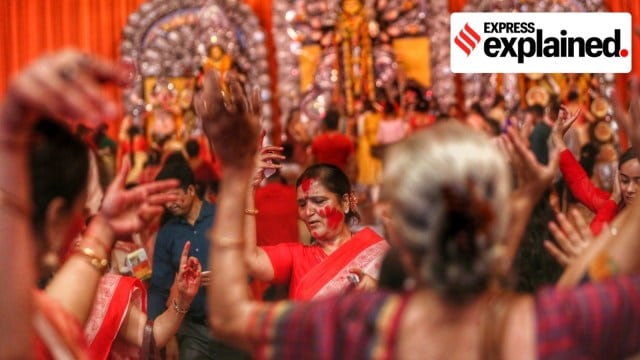‘Videshi’ in one’s own country: Understanding India’s internal diasporas
Ask any Odia migrant worker in Surat where they have come to work and they will say ‘videsh’. So what really makes a diaspora?
 Women dance during sindoor khela at a Durga Puja pandal in CR Park, New Delhi. Diasporic identities are often cultivated by associations. (Express Photo by Tashi Tobgyal)
Women dance during sindoor khela at a Durga Puja pandal in CR Park, New Delhi. Diasporic identities are often cultivated by associations. (Express Photo by Tashi Tobgyal)Ever since the High-Level Committee on the Indian Diaspora published its report in 2001-02, the word ‘diaspora’ has gained currency in policy circles.
The size of India’s diaspora, estimated in 2001-02 to be over 20 million, is currently estimated to be over 30 million. And there have been over 2,000 studies so far on various aspects of India’s international diaspora.
But is a national border necessary to define a diaspora? And is that even feasible in India, where the words ‘pravasi’ and ‘videshi’ are used not only for international emigration but also for long-distance internal migration. Ask any Odia migrant worker in Surat, Gujarat, where they have come to work and they will say videsh.
For a diasporic experience, it is important to cross a significant cultural zone which may be internal or international. And yet, compared to the studies on international diasporas, we know very little about internal diasporas.
What do we know about these internal diasporas, as opposed to simply internal migration?
For instance, Madurai district in Tamil Nadu counts virtually no ‘migrants’ from Gujarat in the recent migration Censuses and yet reports over 60,000 Gujarati speakers in the language Censuses, more than the size of India’s diaspora in most countries of the world.
Diasporas after all are a culmination of recent migrations and past migrations, such as the Indian migration to Mauritius in the 19th century that has led to the creation of an Indian diaspora there today.
In a recent paper published in the journal Sociological Bulletin, I estimated the internal and international diasporas based on the major languages of India. For internal diasporas, recent language Censuses were used, excluding border-districts on state boundaries. For international diasporas, other countries’ language Censuses and other sources were used to form estimates. The results were striking.
When accounting for internal diasporas, the ‘diasporic’ experience of Indians is not 30 million but well over 100 million.
| The internal and international diasporas of India | |||
| Language | Size of diaspora* (millions) | Size of diaspora/number of speakers (%)* | Ratio of international & internal diaspora |
| Punjabi** | 4.3 | 12.4 | 0.8 |
| Malayalam | 4.6 | 12.2 | 1.8 |
| Tamil | 8.4 | 11.5 | 1.2 |
| Telugu | 7.9 | 9.7 | 0.1 |
| Gujarati | 4.9 | 8.7 | 0.3 |
| Hindi | 39.9 | 7.5 | 0.2 |
| Marathi | 5.5 | 6.6 | 0.1 |
| Kannada | 2.0 | 4.6 | 0.2 |
| Bengali** | 3.6 | 3.7 | 0.2 |
| *In 2010; **Refers to Indian international diaspora | |||
Punjabi, Malayalam and Tamil were the most dispersed language groups relative to their sizes (over 10 %), followed by Telugu and Gujarati. Hindi (which includes Bhojpuri and Marwari in the Indian Census) speakers form the largest segment of India’s diaspora but are relatively less dispersed relative to overall size. Marathi, Kannada and Bengali were the least dispersed.
As with the international diaspora, there are ‘old’ internal diasporas and ‘new’ internal diasporas linked with the recency of migration. There is the diaspora formed by old Gujarati migration to Tamil Nadu linked with weavers and traders several centuries ago, and more recent ones formed in Karnataka and Maharashtra linked with business-related migrations.
There is a significant Telugu diaspora in West Bengal and Maharashtra, in addition to the better-known Telugu diaspora abroad in the US. In fact, barring Malayalam and Tamil, all other major language groups had larger internal diasporas than international diasporas. And a third of the internal diaspora was spread across India’s ten largest cities.
Diasporic identities are often cultivated by associations: think of Bengali associations that host Durga Pujas, Marathi Mandals and the spread of the Ganapati festival, and various Gujarati Samaj bodies around the world. At one point, the Gujarat State Non-Resident Gujaratis Foundation listed 176 Gujarati associations within India and 120 outside.
The preservation of language is an important aspect of diasporic groups, but it may fade over time. Some diasporas have learnt the local languages along with retaining their own ones whereas in extremely cosmopolitan settings, local languages were never seen as important to learn.
Many of the challenges of integration and conflicts between first and second generation migrants within families, as depicted in Jhumpa Lahiri’s novel The Namesake, in the case of international migration, can be observed among the internal diasporas as well.
Despite being thrice in size, internal diasporas have been understudied when compared to international diasporas. Understanding the two diasporas as an outcome of linguistic dispersion also helps in outlining their intimate interlinkages.
Antwerp’s diamond connection with Surat and West Asian oil firms’ labour linkages with Kerala were both facilitated by a sizable Gujarati and Malayalam diaspora in Mumbai. Internal migration is often the trigger behind international migration for communities and, in some cases, even vice versa.
Constraining the concept of the diaspora to national borders is a flawed idea that must be rectified to understand Indian diversity, or for that matter, the diversity of any large nation.
India’s diasporic experiences far exceed 30 million and are closer to 100 million, and they greatly matter in the spread of customs and cuisines, not only around the world but also within India. It is only when we understand the transnational from the subnational that we begin to recognise the full meaning of what it means to be videshi, outside or within one’s own country.
Chinmay Tumbe is with the Indian Institute of Management Ahmedabad and author of India Moving: A History of Migration (2018). His paper ‘The Internal and International Diasporas of India’ was published in the journal Sociological Bulletin on August 13
- 01
- 02
- 03
- 04
- 05






































